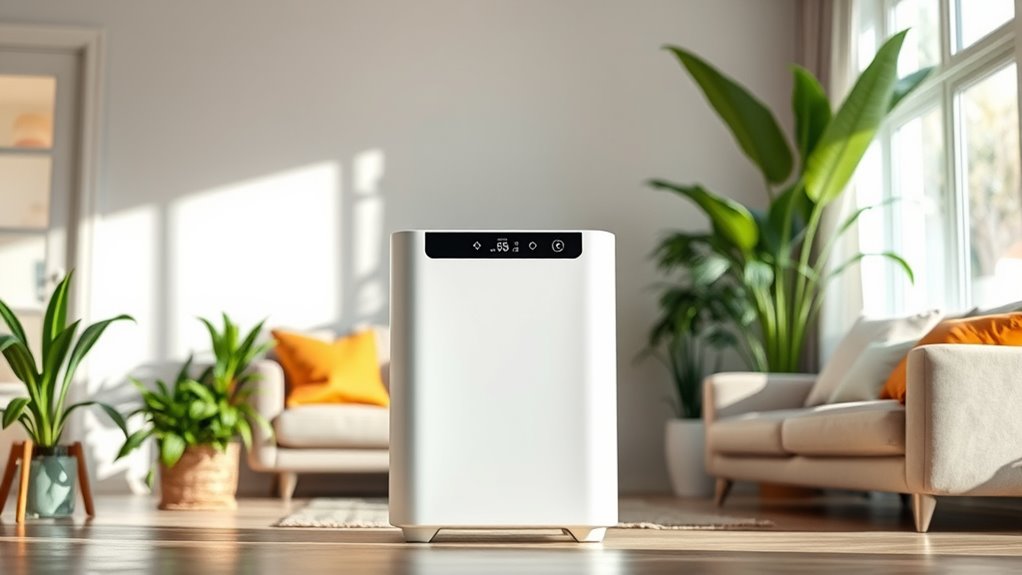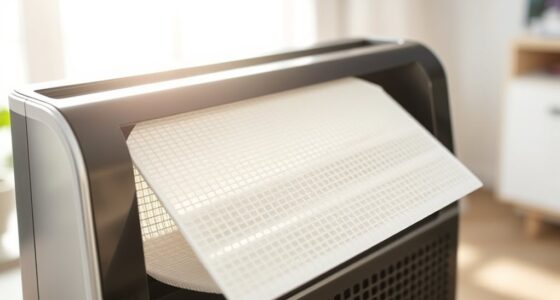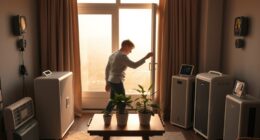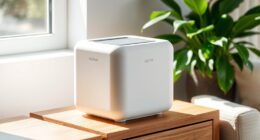When choosing a smart air purifier, focus on models with accurate air quality sensors that monitor pollutants, allergens, and VOCs in real-time. App control features, like remote operation, detailed data, and scheduling, make it easier to keep your air clean effortlessly. Integration with other smart devices and voice commands can boost convenience. If you want to understand which features truly enhance performance and ease of use, keep exploring these key aspects.
Key Takeaways
- Accurate air quality sensors that detect pollutants, allergens, and particles for real-time monitoring.
- User-friendly app control for remote operation, adjustments, and scheduling.
- Integration with home automation systems for seamless smart ecosystem connectivity.
- Real-time data insights and notifications to stay informed about indoor air quality.
- Features like automatic adjustments and energy-efficient modes to optimize air purification.

Have you ever wondered how to improve the air quality in your home effortlessly? Smart air purifiers make that possible by combining advanced technology with user-friendly features. Two of the most important features you should look for are air quality sensors and app control. These tools work together to give you real-time insights and seamless management, ensuring your indoor air stays clean without much effort.
Air quality sensors are the backbone of a smart air purifier’s effectiveness. They continuously monitor the levels of pollutants, allergens, and particles in your home’s air. When the sensors detect a spike in dust, pollen, or volatile organic compounds (VOCs), the purifier automatically kicks into higher gear. This means you don’t have to guess when to turn it on or off; it responds dynamically to the environment. With accurate sensors, you can trust that the purifier is working efficiently, maintaining ideal air quality at all times. This is especially helpful if someone in your household has allergies or respiratory issues, as the device will adjust its operation to keep the air as clean as possible.
Air quality sensors ensure your purifier adapts instantly for cleaner, healthier air at all times.
App control elevates the convenience factor. Most smart air purifiers come with a dedicated app that you can install on your smartphone or tablet. With app control, you can turn your purifier on or off remotely, adjust settings, and receive alerts—no matter where you are. Want to check the air quality before you arrive home? Just open the app. Need to change the fan speed or activate a specific mode? It’s all at your fingertips. Some apps even provide detailed data on the air quality over time, so you can observe patterns and understand how different activities affect your home’s environment. Plus, app control often allows scheduling, meaning you can set the purifier to operate during certain hours, saving energy and ensuring fresh air whenever you need it. Additionally, understanding personal finance management principles can help you budget for and select the most effective smart air purifier within your financial means.
Together, air quality sensors and app control create a smart ecosystem that simplifies maintaining a healthy indoor environment. They eliminate guesswork and manual adjustments, giving you peace of mind that your air is being monitored and optimized continuously. In addition, many smart purifiers with these features integrate with home automation systems, allowing voice commands or automated routines. This integration makes managing your air quality even more effortless. When choosing a smart air purifier, prioritize these features, as they directly impact the device’s responsiveness and your overall convenience. With them, you’re not just buying a gadget—you’re investing in a smarter way to breathe easier every day.
Frequently Asked Questions
How Do Smart Air Purifiers Compare to Traditional Models?
When comparing air purifiers, smart models often outperform traditional ones by offering advanced features. You can rely on air quality sensors to monitor your home’s air in real-time, and app connectivity allows you to control and customize settings remotely. These features help you maintain peak air quality effortlessly, making smart purifiers more convenient and efficient than traditional models, which usually lack such real-time data and remote management options.
Can Smart Purifiers Improve Allergies Better Than Standard Ones?
Imagine a superhero fighting allergies—smart purifiers do that better than standard ones. They actively detect air quality and adjust filter removal, ensuring you’re protected. Plus, their noise levels stay low, so you hardly notice they’re working. This makes them more effective at reducing allergens like pollen and pet dander. You’ll breathe easier, knowing your smart purifier adapts precisely to improve your allergy symptoms better than traditional models.
Are There Energy Efficiency Concerns With Smart Air Purifiers?
You might wonder if energy consumption is a concern with smart air purifiers. These devices typically have higher power usage due to features like Wi-Fi connectivity and sensors. However, many models are designed to optimize power usage, turning off or adjusting operation when not needed. If energy efficiency matters to you, look for purifiers with low power consumption ratings and energy-saving modes to reduce overall power usage and save on electricity bills.
How Secure Is the Data Collected by Smart Air Purifiers?
While you might worry about your smart air purifier’s data security, it’s reassuring to know that many companies use data encryption to protect your information. However, you should also read privacy policies carefully, as they detail how your data is stored and shared. Like clean air, secure data depends on good practices; stay informed and choose brands committed to safeguarding your privacy.
Do Smart Air Purifiers Require Professional Installation?
You don’t need professional installation for most smart air purifiers; they’re designed for easy DIY setup. You can typically plug them in, connect via Wi-Fi, and follow simple instructions. If you run into issues, technical support is available to help you troubleshoot. This way, you save time and money, and you get your purifier running quickly without waiting for a technician.
Conclusion
When choosing a smart air purifier, prioritize practical features like real-time air quality monitoring, seamless connectivity, and user-friendly controls. Don’t get distracted by flashy functions that don’t fulfill your needs. Focus on the features that truly filter out pollutants and improve your space. By balancing benefits with your budget, you’ll breathe easier and enjoy cleaner air. Remember, the best purifier is the one that fits your lifestyle, so select smartly and breathe confidently!









